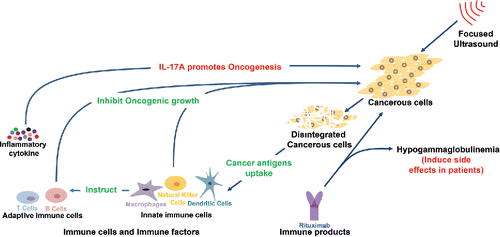Cellular stress triggered by living and non-living entities may dysregulate cellular processes, DNA proofreading and cell division, resulting in the transformation of cells and hence the development of cancer. The host immune system can recognize promptly and eliminate transformed cells through immune effector cells that mediate apoptosis of tumor cells. The manipulation of host immunity through the utilization of immune product such as monoclonal antibodies or cytokines are key components for development of appropriate cancer immunotherapy. This issue of the International Reviews of Immunology focuses on the interaction of host immunity with cancer ().
Tight regulation is essential for immune homeostasis which ensures elimination of pathogens and curbs proliferation of transformed cells. Thus, dysregulation of immunity may promote a wide range of pathologies such as autoimmune disease and cancer. The first review article of this issue by Schäfer et al. discusses the advantages of the utilization of innate immune cells for immunotherapy, inducing immediate responses and also instructing adaptive immune cells such as B and T cells to modulate autoimmune diseases and cancer. The authors compare advantage and disadvantage B and T cells based immunotherapy. The article may be useful to basic and translational immunobiologists and researchers with interest in cancer immunotherapy.
Globally, immunotherapy researchers are putting an immense effort to eradicate cancer. The second review article by Maloney et al. highlights the importance of non-invasive focused ultrasound (FUS) in the treatment of pancreatic ductal adenocarcinoma (PDA) and discusses how FUS facilitate activation of PDA-directed innate and adaptive immunity. The authors also suggested that FUS may enhance the efficacy of immune-therapy in other cancers, leading to better treatment regimens ().
Various recombinant products such as cytokines and monoclonal antibodies (MAb) specific for cancer antigens are widely used in the treatment of cancer. The third review article by Christou et al. describes some disadvantages associated with Rituximab treatment, an anti-CD20 MAb which is used against various types of B cell malignancies and autoimmune diseases. The authors highlighted the on target effect leading to hypogammaglobulinemia and underlined molecular mechanisms which are linked with the Rituximab treatment in cancer and rheumatoid arthritis patients. The article may benefit the basic researchers and medical practitioners involved with development and utilization of monoclonal antibodies.
The subtype of T helper cells called Th17 secretes IL-17A which plays a defensive role during bacterial and fungal Infection. The last review article of this issue by Xy et al. describes the tumorigenic and pro-metastatic properties of IL-17A. The article also provides insights into the molecular mechanism of IL-17A-related oncogenesis. This article suggests novel strategies for cancer immunotherapy.
References
- Schäfer C1, Ascui G1, Ribeiro CH, et al. Innate immune cells for immunotherapy of autoimmune and cancer disorders. Int Rev Immunol. 2017;36(6):1–23.
- Maloney E, Khokhlova T, Pillarisetty VG, et al. Focused ultrasound for immuno-adjuvant treatment of pancreatic cancer: an emerging clinical paradigm in the era of personalized oncotherapy. Int Rev Immunol. 2017;36(6):1–14.
- Christou EAA, Giardino G, Worth A. Risk factors predisposing to the development of hypogammaglobulinemia and infections post-Rituximab. Int Rev Immunol. 2017;36(6):1–18.
- Xu LL, Li ZJ, Niu XL. The Mechanisms of IL-17A on Promoting. Tumor Metastasis Int Rev Immunol. 2017;36(6):1–10.

